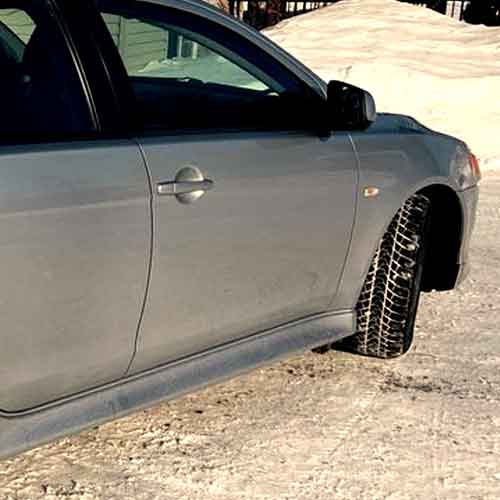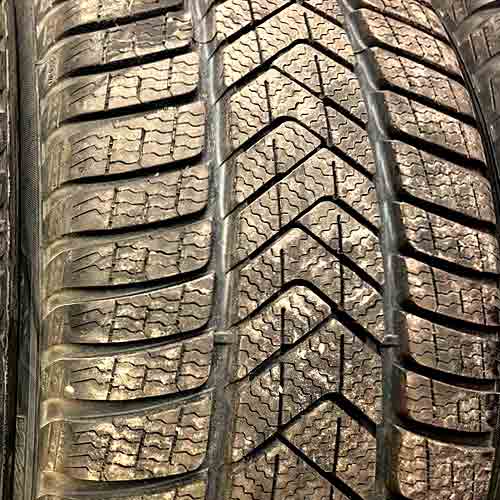Pirelli’s Winter Sottozero 3 is a blend of style and winter functionality, providing you with very appreciable ice and snow performance. Let’s see what else this tire has to offer for you.

Table of Contents
Key Takeaway
So overall, looks like the Pirelli’s tire has some more drawbacks compared to its pros.
The tire excels in:
- Fuel efficiency due to its special rubber compound.
- Efficient water dispersion due to its directional tread pattern.
- Dampening road irregularities, offering a smoother ride.
- Handling snow-covered terrains with its interlocking lugs and shoulder design.
Though, the Winter Sottozero 3 needs improvement in a lot of areas, including:
- Minimizing tread noise due to its open shoulder design.
- Dry surface linear grip and overall handling, especially in braking and acceleration.
- Tread longevity, as it shows quicker wear.
- Ice traction compared to other options in the market.
Info on Sizes: The Pirelli Winter Sottozero 3 comes in 16 to 21 inches with speed ratings of H, V and W, tread depth of 10/32″ on all sizes, and weight going from 18 lbs to 32 pounds. Moreover, the tire doesn’t offer any treadwear warranty.
Also Note: Since the tire offers best fuel economy, I added it to my list of top studless winter options, check it here:
https://snowytires.com/best-studless-winter-tires/
Tire Construction
The Pirelli Winter Sottozero 3 features a directional tread design, like mostly winter tire do.

Now the tire’s tread comes with 3 prominent ribs, with two outer shoulder ribs and the central one.
All of them have similar widths, and feature same siping pattern too.
Though the angles of sipes vary from one another.
The central most rib comes with V shaped biters, joined up by longitudinal slits, acting as in-groove notches.
With this the two wide circumferential grooves the tread has are inter-connected with each other.
Moving towards the shoulder area, elongated lugs come into view, featuring wider lateral tread voids in between.
These lugs are characterized by similar wave-like siping and longitudinal slits, designed for gripping on snow (especially while cornering).
Overall Wet Performance
Effective wet performance relies on a tire’s tread design and rubber composition, both tailored to handle water displacement and maintain contact with wet surfaces.
Now the Pirelli Winter Sottozero 3 has all the tread elements, highly needed here.
First off, it forms clear (outer two) circumferential grooves, and interconnect them laterally, with it’s voided up central rib.
This allows for effective water evacuation through grooves, allowing for superior float speeds, and resistance to hydroplaning.
Moreover, with more water going out, sipes have less burden, which is great for overall wet traction.
These sipes act as vacuum cleaners, sucking up water particles coming underneath. And since they change angles from rib to rib, they are able to provide grip in all directions too.
So overall, the Pirelli offers appreciable overall wet traction.
Though if wet traction is your main concern, you should know that the Michelin Pilot Alpin PA4 (review) is the best among it’s direct competitors.
Comfort Performance
There are two dimensions of overall comfort. Tire’s vibration dampening and noise reduction. Both of these are influenced by tire construction and design patterns.
Tread Noise Reduction
Tire tread noise results from air turbulence within tread patterns. That’s why larger voids in the tread can increase noise due to amplified air disturbances.
That’s why the Pirelli Winter Sottozero 3 is not a quiet tire by any means. It’s open shoulders clearly allow air to come in with ease and hit around causing noise.
Moreover, with a ton of siping, the tire also produces a lot of growling, adding to it’s below average performance here, comparing other tires in the category, I mean.
Vibration Absorption
A tire’s shock-absorbing capabilities impact ride comfort, where both internal tire structure and external design contribute to it.
Now the Pirelli Winter Sottozero 3 is a pretty decent tire here, as it dampens road irregularities with ease, providing a smoother ride relatively.
The tire has a softer compound to begin with, and internally features a dedicated layer to settle down road bumps.
Overall Dry Performance
Traction on dry surfaces is essential, with consistent rubber contact and adaptability to different road conditions playing a crucial role.
Here two dimensions come in to light, tire’s linear grip and overall handling encompassing lateral traction and steering.
Let’s check all of them one after another.
Dry Linear Grip
Linear grip relates to a tire’s performance in a straight-line, where the central tread region, bearing the most weight, contribute the most to overall on-center stability and grip.
Also since its a directional metric, it makes sense why its measured by the tire ability to grip (predominately), and accelerate.
Having said that, the Pirelli Winter Sottozero 3 is slightly lacking here, as its central most rib is pretty voided up. Meaning there’s less rubber (as most of it is lost to grooves), meeting the road, limiting overall grip.
That’s why compared to it’s (top performing) direct competitor here, the tire lacks by over 5 feet (in braking test).
Dry Handling and Steering
Overall handling is the combination of tire’s grip with it’s lateral stability (vital for responsive handling).
Now, here although the Winter Sottozero 3 provides decent lateral traction (as seen by its appreciable g forces, on average), the tire still comes below average among its competitors.
And that’s mainly because of it’s lacking directional grip.
I mean the tire offers good enough lateral grip and steering response, but with slower braking, it takes more time, while entering the corners.
Similarly, once out of the corner, where you need to accelerate back again, the tire again lacks with its less effective acceleration capability.
So overall you get below average dry handling performance on Pirelli, compared to it’s direct competitors.
Tread Longevity
Tread life depends on a lot of different variables, including grip, lug flexibility, tire’s weight/composition/design. Let’s take a look at all of them one by one to explain why the Winter Sottozero 3 isn’t so great here.
In case of grip, as the tire comes with pretty gripping rubber, showcasing speed ratings up to W, you get a lot of rolling friction, affecting its tread longevity.
Moreover, although the tire is not heavier (comparatively/relatively), it’s voided up structure still places a lot of pressure upon lugs, as the rub with the surface (they’re on) with a lot of friction.
And this further increases it’s tread wearing.
Though, sizes with lower speed ratings, do better.
And overall you can expect these tires to live up to 40k miles, on average.
Overall Winter Performance
When we think of winter, images of snow-covered landscapes and icy roads come to mind. So its best if we split this section in to two of these terrain types.
Ice Traction
Assessing a tire’s ability to tackle icy surfaces involves considering some crucial factors.
These include tire’s responsiveness (of tread), especially in low temperatures and the intricate details of its tread design, which enhance grip on slippery ice.
Having said that, although the Pirelli Winter Sottozero 3 comes with a ton of overall biters, it’s still can’t offer you with above-average overall ice performance. I mean there are much better option out there, outperforming this tire here.
Snow Traction
Navigating snow-covered roads requires a tire to effectively:
- Form snow to snow contact, as snowflakes stick better to each other, compared to rubber.
- Scoop snow backwards, to generate acceleration.
And the Pirelli Winter Sottozero 3 is a good enough in both these areas.
It’s interlocking central lugs provide ample capturing of snow, providing decent snow braking, while the shoulder lugs act as shovels, providing with the needed acceleration.
Though the tire could use some improvement in terms of steering responsiveness, in overall snow handling.
Fuel Economy
A tire’s weight and traction characteristics determine rolling resistance, impacting vehicle fuel efficiency.
That’s because greater weight, increases the push on the lugs, enhancing friction, and fuel usage.
Now the Pirelli Winter Sottozero 3 is one of the best in this regard, as the tire offers super tread composition here, which includes special polymers which are environment friendly.
The tire weighs a little, and with voided up design it lugs are stressed more because of that, the tire’s rubber blend still keep the rolling friction values at bay.
So you get top notch results on this tire in terms of fuel economy.
To Sum Up
So overall, the Pirelli tire offers a lot of varying performance metrics.
It’s directional pattern offers superb wet traction, and resistance to hydroplaning. And the tire offers decent performance in terms of winter conditions as well.
(Though its snow performance is more appreciable, compared to its ice traction).
As for dry, although the tire offers decent lateral grip, its overall handling times suffer because of it’s lacking directional grip.
In terms of comfort, while the tire dampens road irregularities effectively, it falls short in minimizing tread noise due to its open shoulder design.
And in terms of fuel economy, the tire’s softer compound combined with its tread structure results in greater energy consumption, leading to below-average fuel efficiency.
Lastly, since the very same factors also apply to its tread life, you also get below average performance when it comes to treadwear as well.